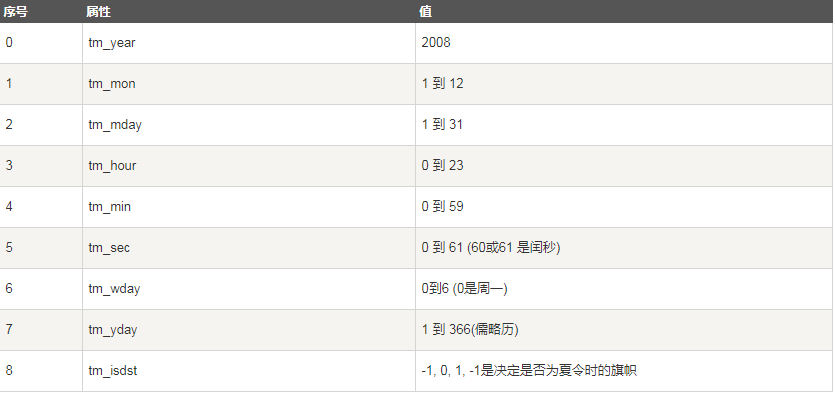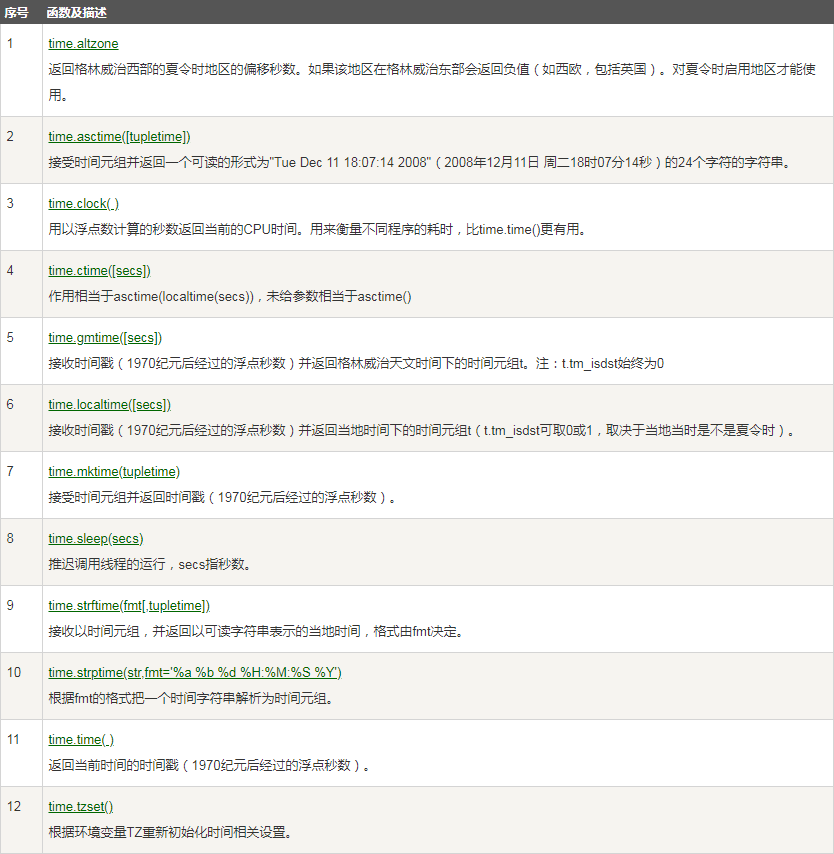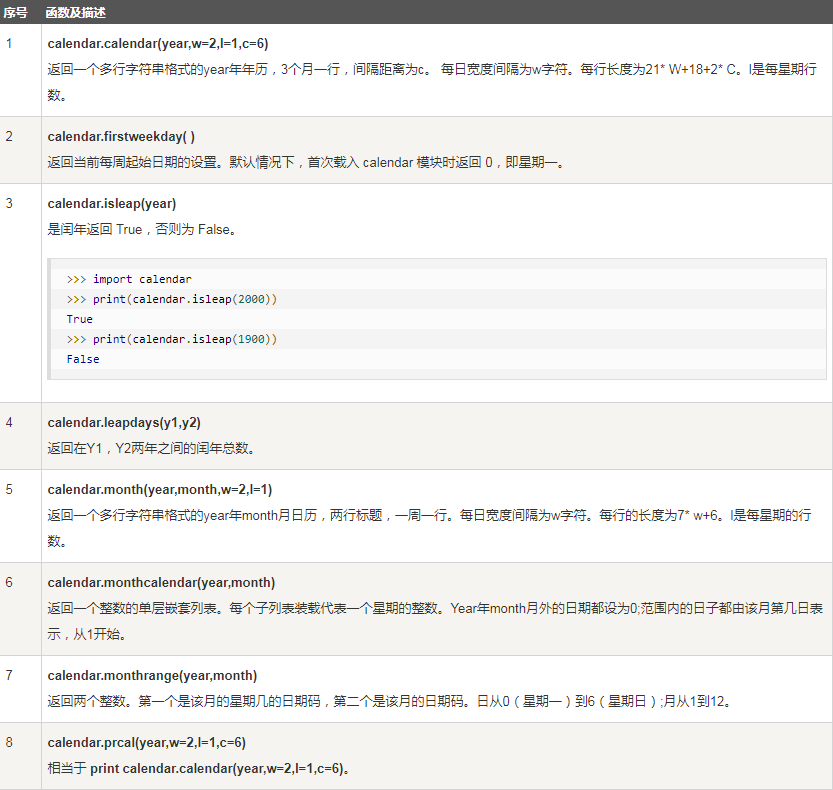# Python日期和时间
Python 程序能用很多方式处理日期和时间,转换日期格式是一个常见的功能。
Python 提供了一个 time 和 calendar 模块可以用于格式化日期和时间。
时间间隔是以秒为单位的浮点小数。
每个时间戳都以自从1970年1月1日午夜(历元)经过了多长时间来表示。
Python 的 time 模块下有很多函数可以转换常见日期格式。如函数time.time()用于获取当前时间戳, 如下实例:
```
#!/usr/bin/python
# -*- coding: UTF-8 -*-
import time; # 引入time模块
ticks = time.time()
print "当前时间戳为:", ticks
```
以上实例输出结果:
~~~
当前时间戳为: 1459994552.51
~~~
时间戳单位最适于做日期运算。但是1970年之前的日期就无法以此表示了。太遥远的日期也不行,UNIX和Windows只支持到2038年。
## 什么是时间元组?
很多Python函数用一个元组装起来的9组数字处理时间:

上述也就是struct\_time元组。这种结构具有如下属性:

## 获取当前时间
从返回浮点数的时间戳方式向时间元组转换,只要将浮点数传递给如localtime之类的函数。
```
#!/usr/bin/python
# -*- coding: UTF-8 -*-
import time
localtime = time.localtime(time.time())
print "本地时间为 :", localtime
```
以上实例输出结果:
~~~
本地时间为 : time.struct_time(tm_year=2016, tm_mon=4, tm_mday=7, tm_hour=10, tm_min=3, tm_sec=27, tm_wday=3, tm_yday=98, tm_isdst=0)
~~~
## 获取格式化的时间
你可以根据需求选取各种格式,但是最简单的获取可读的时间模式的函数是asctime():
```
#!/usr/bin/python
# -*- coding: UTF-8 -*-
import time
localtime = time.asctime( time.localtime(time.time()) )
print "本地时间为 :", localtime
```
以上实例输出结果:
~~~
本地时间为 : Thu Apr 7 10:05:21 2016
~~~
## 格式化日期
我们可以使用 time 模块的 strftime 方法来格式化日期,:
~~~
time.strftime(format[, t])
~~~
实例演示:
```
#!/usr/bin/python
# -*- coding: UTF-8 -*-
import time
# 格式化成2016-03-20 11:45:39形式
print time.strftime("%Y-%m-%d %H:%M:%S", time.localtime())
# 格式化成Sat Mar 28 22:24:24 2016形式
print time.strftime("%a %b %d %H:%M:%S %Y", time.localtime())
# 将格式字符串转换为时间戳
a = "Sat Mar 28 22:24:24 2016"
print time.mktime(time.strptime(a,"%a %b %d %H:%M:%S %Y"))
```
以上实例输出结果:
~~~
2016-04-07 10:25:09
Thu Apr 07 10:25:09 2016
1459175064.0
~~~
python中时间日期格式化符号:
* %y 两位数的年份表示(00-99)
* %Y 四位数的年份表示(000-9999)
* %m 月份(01-12)
* %d 月内中的一天(0-31)
* %H 24小时制小时数(0-23)
* %I 12小时制小时数(01-12)
* %M 分钟数(00-59)
* %S 秒(00-59)
* %a 本地简化星期名称
* %A 本地完整星期名称
* %b 本地简化的月份名称
* %B 本地完整的月份名称
* %c 本地相应的日期表示和时间表示
* %j 年内的一天(001-366)
* %p 本地A.M.或P.M.的等价符
* %U 一年中的星期数(00-53)星期天为星期的开始
* %w 星期(0-6),星期天为星期的开始
* %W 一年中的星期数(00-53)星期一为星期的开始
* %x 本地相应的日期表示
* %X 本地相应的时间表示
* %Z 当前时区的名称
* %% %号本身
## 获取某月日历
Calendar模块有很广泛的方法用来处理年历和月历,例如打印某月的月历:
```
#!/usr/bin/python
# -*- coding: UTF-8 -*-
import calendar
cal = calendar.month(2016, 1)
print "以下输出2016年1月份的日历:"
print cal
```
以上实例输出结果:
~~~
以下输出2016年1月份的日历:
January 2016
Mo Tu We Th Fr Sa Su
1 2 3
4 5 6 7 8 9 10
11 12 13 14 15 16 17
18 19 20 21 22 23 24
25 26 27 28 29 30 31
~~~
## Time 模块
Time 模块包含了以下内置函数,既有时间处理的,也有转换时间格式的:

Time模块包含了以下2个非常重要的属性:

## 日历(Calendar)模块
此模块的函数都是日历相关的,例如打印某月的字符月历。
星期一是默认的每周第一天,星期天是默认的最后一天。更改设置需调用calendar.setfirstweekday()函数。模块包含了以下内置函数:


## 其他相关模块和函数
在Python中,其他处理日期和时间的模块还有:
* [datetime模块](http://docs.python.org/library/datetime.html#module-datetime)
* [pytz模块](http://www.twinsun.com/tz/tz-link.htm)
* [dateutil模块](http://labix.org/python-dateutil)
